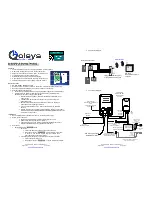
Mind State Management
3
Describing the consciousness continuum
Mind State Management involves many specific skills and strategies for effecting
pos itive changes to human consciousness. Consciousness, the subjective state of
awareness of one’s mind state, can be viewed as a continuum from hyperactivation
to virtual coma. While this description does not take into account the physiology of
the brain, its does provide a useful framework upon which to map the general states
of arousal which are associated to processing certain types of information and per-
forming certain kinds of tasks. It is an oversimplification to describe all parts of the
brain as if they resonate uniformly to one vibration; the brain is far more complex
than that. Nor is it accurate to describe left brain functions only as primarily linear
and logical, and right brain functions only as intuitive, unconscious, and spatial.
The metaphor of a continuum, though, allows us a convenient way to understand
the fairly consistent patterns of brain functioning common to most people.
The brain operates like a computer which is not surprising since computers were
designed to emulate brain functions in the first place. There are input devices (data
from our senses), coding systems (categorizations and cognitive appraisals of our
perceptions based on previous experiences) and a central processing unit. There is
also a power source (motivation) that pre-selects certain information for processing
and ignores data considered irrelevant. There are also output devices in which data
is categorized (cross-referenced in both the conscious and unconscious long-term
memory systems). If the encoding is sloppy or the data has relatively low impor-
tance to functioning, it tends to be lost (forgotten). It is eventually overwritten or
erased by subsequent information (new experiences).
While most of the information is stored, it is almost virtually unretrievable unless
properly tagged to a retrieval path. For example, with no external cueing, try to re-
member who you had lunch with three Tuesdays ago. For most people this is not an
easy assignment, yet the memory is there.
Imagine the distress of taking an examination and temporarily blocking the correct
answers due to the stress of having to produce on demand. Imagine the difficulty in
trying to fall asleep when your sleep cycle has been disrupted by jet lag. Or trying to
read a chapter of a textbook when you are tired. Each of these activities require cer-
tain levels of brain state activation in order to be carried out effectively. The impor-
tance of this principle is far from insignificant. Disruptions to brain functioning can
affect cognition, emotion, attitude and ultimately behavior. What is needed then is
the ability to access the state that is optimal to the task at hand.
What are brainwaves?
Essentially, our brain is a neurochemical information
processor that gives off electrical signals as electrochemical circuits close and open
a million each second. If this is so, why can’t we detect these signals? Primarily
because our skulls are too thick and the signals too weak for them to resonate out-
side our heads. With the exception of perhaps the most clairvoyant and telepathic
among us, brainwave patterns are impossible to detect without the aid of a special
Summary of Contents for Mind'sEye
Page 1: ...User s Guide Reference Mind sEye Mental Fitness System TM...
Page 2: ......
Page 3: ...Mind sEye Mental Fitness System User s Guide Reference TM...
Page 8: ......
Page 22: ......
Page 62: ......
Page 63: ......












































